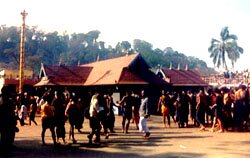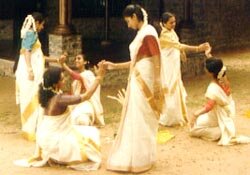|
|
|
|
| Fairs and Festivals |
|
|
Onam-The National Festival of Kerala | Vishu | Navarathri | Mahasivarathri | Makaravillakku at Sabarimala | Thrikarthika | Thiruvathira | Christmas | Easter | Ramadan | Eid-Ul-Fitr | Eid-Ul-Zuha | Milad-Ul-Nabi | Muharram | Gramam(Village Fair) | The Great Elephant March | Nishagandhi Dance Festivals | Flavour Food Festival | Attukal Pongala | Vetta and Arattu | Sarkara Devi Temple, Chirayinkeezhu | Sree Subramanya Swamy Temple, Ulloor | Aruvippuram Siva Temple, Aruvippuram | Thiruvambadi Sree Krishna Temple | Christ the King Church | Beemapalli, Trivandrum
|
|
| Makaravillakku at Sabarimala |
|
For centuries, Sabarimala in Pathanamthitta has been a major pilgrim centre attracting lakhs of devotees from all over India, more so from southern States. The presiding deity is Lord Ayyappa known as Dharma Sastha, a considered symbol of unity between Vaishnavites and Saivites. Darma Sastha is believed to have fulfilled his mission in life and rejoined his Supreme Self, enshrined at Sabarimala.
|
|
The temple is tucked away in the mountain ranges of the Western Ghats and can be reached only by foot. Pilgrims have to traipse through the narrow tracks in thick forests infested with wild animals.
Pilgrims to Sabarimala is seasonal (November to January). Those wishing to perform pilgrimage have to undergo forty-one days penance consisting of strict celibacy, daily ablutions and daily prayers.
|
 |
|
|
Early mornings and evenings in the festival season Kerala villagers will be reverberating with dedication calls of Ayyappa devotees. The festival mood reaches its crescendo on Makara Vilaku day( January 14, the most important day in the festival). The day synch with the day of Sankramom (crossing of the sun from Dhakshinayana to the Uttarayana).
|
|
On the said day, lakhs of pilgrims( each one called an Ayyappa), flock the shrine for worship. On that evening they descry Makara Vilakku, appearance of a strange light in the distant hill indicating the presence of God and return ennobled and strengthened in spirit.
|
|
Situated not far from the is a shrine in the name of Vavar, a Muslim, who was thought to be a close aide of Sri Ayyappa. It is a rare experience to see the Hindu devotees worshipping at the shrine of Vavar indicating the communal harmony in Kerala.
|
|
Thrikarthika
|
Top
|
|
Thrikarthika is another festival which is celebrated in the month of Vrichikom (November-December). Display of lights in the evening is an important part of the festival Deepavali , the festival of light is celebrated by the display of fire works and bursting of crackers. The 41 day of Mandalam season beginning with the first day of the month of Vrischikom (November-December) is sacred to the Hindus. The 41st day which coincides with the Makaravilakku in Sabrimala is the concluding day of the festival. The observance of certain vrathams of fasts is resorted to which the Hindu consider sacred to certain deities. The most important of these is Ekadasi considered sacred to Vishnu. At the Sri Krishna Temple, Guruvayoor, the Great Eakadasi festival is held annually for five days in the month of Vrischikom (November- December). Sashti the sixth day is sacred to Subramanya and Pradosham the thirteenth day to Shiva. Devotees spend these days in fasting and devotional excercises. Full moon is also observed as a day of fast. The New Moon days in Makaram (January-February) and Karkatakam (July-August) are particularly important for the performance of Sradha. Karkataka Vavu is almost like a festival day in Trivandrum .
|
|
Thiruvathira
|
Top
|
|
The festival falls on the asterism Thiruvathira in the Malayalam month of Dhanu (December-January). On thiruvathira morning, devotees throng Shiva temples for an early worship which is reckoned as highly auspicious.
Tradition says thiruvathira is celebrating the death of Kamadeva, the mythological God of Love. According to another version, Thiruvathira is the birthday of Lord Shiva. The festival has similarities to adra darshan celebrated in Tamil Nadu.
|
|
On the festival day, women discard rice meal, but only take preparations of chama (panicum miliaceum) or wheat. The day's menu include plantain fruits and tender coconuts. They chew betel and redden their lips. A custom that women should chew 108 betel on the day had prevailed among Namboodiris, Ambalavasis (temple-servants) and Nairs ( all Hindu communities). The first thiruvathira after the marriage of a girl is known as puthenthiruvathira or poothiruvathira
|
 |
|
|
( new thiruvathira).Oonjalattom, (swinging on an oonjal (swing) is another amusement women engage themselves with. During the chilly night, women keep vigil for God Shiva and stage Thiruvathirakali, a bewitching dance form.
|
|
Pretty girls in traditional attire circle around a lighted brass lamp, and step to the rhythm of the songs they sing, clapping their hands.
|
|
Pathirappoochoodal,( wearing of flowers at midnight) is still prevalent among women belonging to Namboodiri, Ambalavasis (temple servants) and Nair communities.
|
|
That thiruvathira is still being celebrated with pomp vouch for the enviable position Kerala women enjoyed in the society. The status she occupied at home and in the society had influenced the state's social structure, customs and religious practices.
|
|
Top
|

